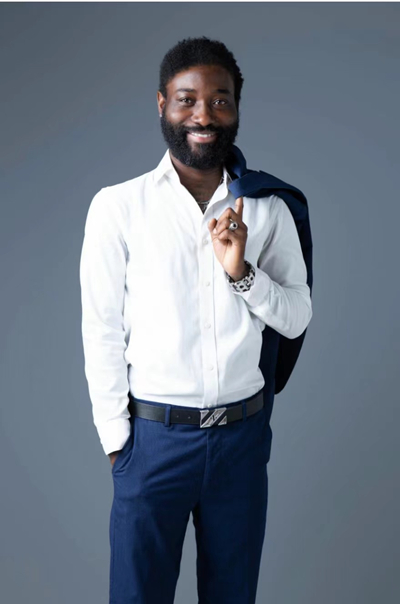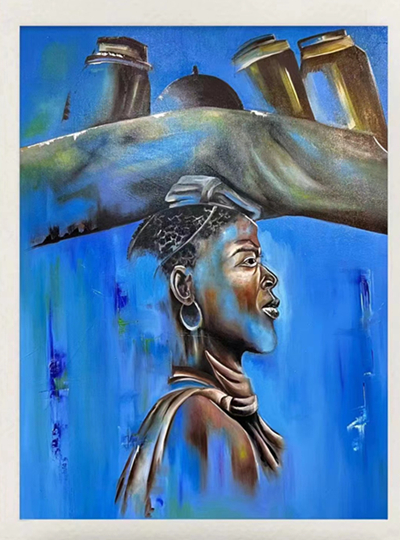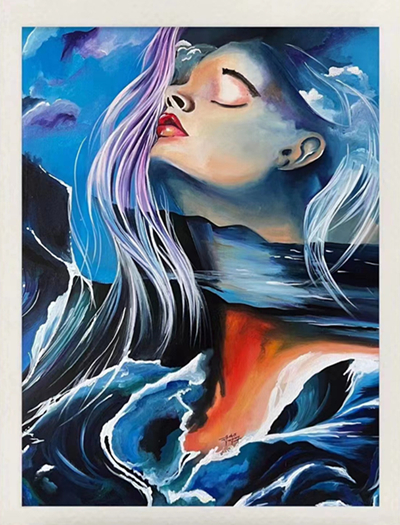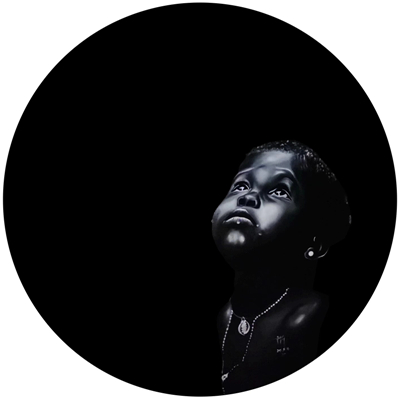|
||||||||||
| Home Nation World Business Opinion Lifestyle ChinAfrica Multimedia Columnists Documents Special Reports |
|
||||||||||
| Home Nation World Business Opinion Lifestyle ChinAfrica Multimedia Columnists Documents Special Reports |
| ChinAfrica |
| Pursuing a Career in Art |
| A Ghanaian artist is engaging with the Chinese society through his creations |
| By Ge Lijun 丨VOL. 14 October 2022 ·2022-09-22 |

Julius Mawuli Kwao
Julius Mawuli Kwao, a Ghanaian, got his Chinese name Ma Wuli by a lovely coincidence. His middle name, Mawuli, sounds similar to the name of well-known xiangsheng (traditional Chinese comedic crosstalk) artist Ma Sanli. The Ghanaian painter enthusiastically adopted it after learning this from his Chinese teacher.
Kwao is busy every day teaching painting at art schools in Beijing. The majority of the students he teaches are Chinese and range in age from 4 to 37. Even with his busy schedule, he never gets exhausted. “I love to paint, but I do it to educate people, not to gain money,” the artist said. The students can choose from a variety of methods, including gouache, oil painting, and sketching.
He believes that art contributes to communication and understanding among people. It displays information-packed visuals in a dynamic, engaging, and direct manner. He uses his African style, especially that of the West African region, as a means of communication with his target Chinese audience. “I want to give them a larger perspective on the cultures and ways of life in my area,” he said.
In fact, this choice was borne out of his personal experience and his audacious choice to travel to China a decade ago.

Kwao’s artworks: The Lives of African Women
A medium of communication
Kwao thinks he is fortunate to learn about China through images. He grew up with a strong passion for this far-off nation that was fostered by Chinese literature and cinema, especially the famous novel A Journey to the West. He developed an interest in the country’s extensive history and outstanding civilization by reading and observing, which helped him to overcome early stereotypes and misunderstandings about China.
His childhood dream to visit China came true at the age of 30. In 2012, he landed in Beijing. “I am here for a certain reason, which is to educate myself,” the painter told ChinAfrica.
He is receiving training in traditional Chinese painting. Although he had studied Western painting in the US before coming, he decided to take up the challenge of a completely different creative genre out of a desire to learn more. He was able to enrol in the same programmes at the Beijing Institute of Fashion Technology as his Chinese classmates after two years of Chinese language training. He created traditional Chinese themes like plum blossoms, orchids, bamboo, and chrysanthemums using Western techniques with the assistance of a painter. His favourite Chinese artist is Zhang Daqian, one of the most accomplished and renowned artists of Chinese painting of the 20th century. “His ink splash artwork has a special place in my heart,” he said.
In college, he gave it a go. Combining both Eastern and Western components intrigued him. Beginning as a battle between two civilisations, it developed into a stimulating mix and conversation. He eventually received his diploma following six years of study at the institute. But his pursuit of knowledge never ended.
In order to promote his work, he frequently participates in fairs oriented at the Chinese audience and teaches and draws there. “Words are inadequate for expression. Painting speaks more clearly,” he said.
One of his pieces depicts an African woman carrying items on her head while she sells them. She has a confident expression despite the weight. “She represents millions of ordinary African women, who earn their living with dignity instead of waiting passively. I try to show the perseverance and persistence of African women in a deprived environment, contrary to some negative images of Africans,” said Kwao. He is pleased that many Chinese people love this painting.
As his father is Ghanaian and his mother is American, he is sensitive to different cultures. As the artist repeatedly emphasises, his dual purpose - he is inspired by Chinese culture and, at the same time, introduces the Chinese to other cultures through his work - is a lifelong mission.

Dream
Expressing the attitude towards life
The Ghanaian painter has attended multiple exhibitions in Chinese cities in addition to his daily work in his studio. As he recalls, “I frequently have to talk a lot to introduce them to the visitors.”
The enthusiasm for his creations, however, does not come from an exotic pursuit, but from a deep sense of life. In one of his paintings, a young woman covers her lips with a finger to display a cheerful outlook on life’s challenges. The artist enumerates this with an example. When there is conflict in your marriage, it is preferable to remain silent. If not, you get home feeling mentally drained. “This work is popular among Chinese visitors, which shows that our two peoples share the same wisdom to some extent,” he said.
Chinese people are particularly moved by his work The African Child. A child raises his head and looks up. This symbolises hope. His mother’s numerous photographs of him as a child served as the basis for this piece. Anywhere, whether wealthy or not, there is hope. The artist claims that you wouldn’t be human if you didn’t have hope.

The African Child
His works are continually a reflection of his conversations with the Chinese. Wanting to stay in China, he established a painting workshop in Beijing where he taught roughly 15 pupils, but he had to stop it due to the COVID-19 pandemic. He therefore made the decision to work with art schools in order to avoid disruption to his preferred career path.
During his 10 years in China, he has seen how the country is gradually developing an artistic culture. The ideal way to introduce novices to the art world is through exhibitions, seminars, educational opportunities, and even movies on the topic. “The public’s active engagement with artistic events is growing, in line with the country’s quick development,” Kwao added.
Because his family, job, and creations are all located in China, he has made the decision to establish roots here. Although she doesn’t work in the art industry, his Chinese wife understands art, according to him. In the future, he wants to open his own art school. Kwao thinks that by doing this, he may introduce more Chinese students to art and provide them with a portal through which to draw inspiration from other cultures.
|
||
| About Us | Contact Us | Advertise with Us | Subscribe |
| Copyright Beijing Review All rights reserved 京ICP备08005356号-5 京公网安备110102005860号 |